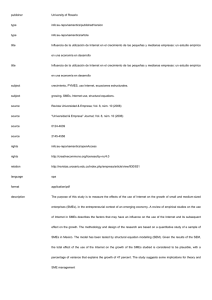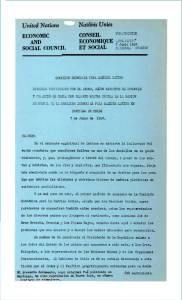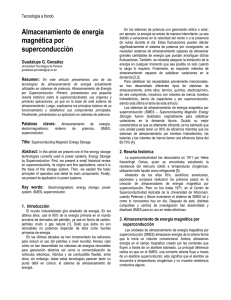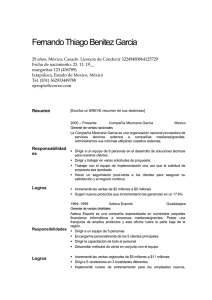Contents, abstracts
Anuncio
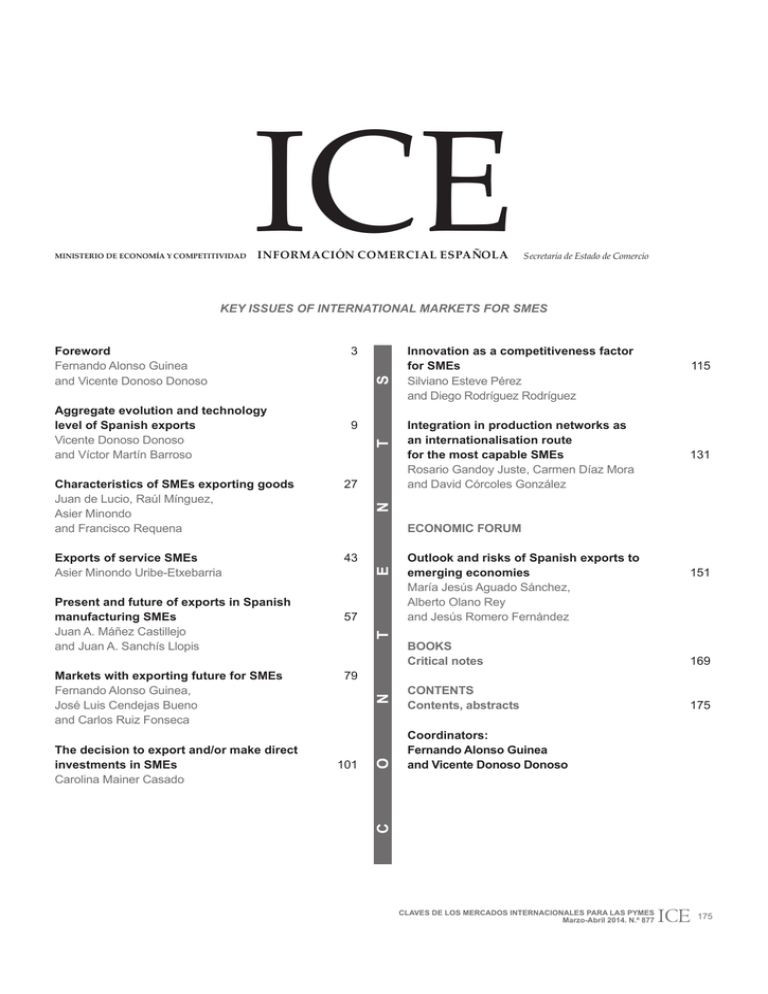
MINISTERIO DE ECONOMÍA Y COMPETITIVIDAD ICE INFORMACIÓN COMERCIAL ESPAÑOLA Secretaría de Estado de Comercio Exports of service SMEs43 Asier Minondo Uribe-Etxebarria Present and future of exports in Spanish manufacturing SMEs57 Juan A. Máñez Castillejo and Juan A. Sanchís Llopis T ECONOMIC FORUM N 79 101 O The decision to export and/or make direct investments in SMEs Carolina Mainer Casado Integration in production networks as an internationalisation route for the most capable SMEs131 Rosario Gandoy Juste, Carmen Díaz Mora and David Córcoles González Outlook and risks of Spanish exports to emerging economies151 María Jesús Aguado Sánchez, Alberto Olano Rey and Jesús Romero Fernández BOOKS Critical notes169 CONTENTS Contents, abstracts175 Coordinators: Fernando Alonso Guinea and Vicente Donoso Donoso C Markets with exporting future for SMEs Fernando Alonso Guinea, José Luis Cendejas Bueno and Carlos Ruiz Fonseca Innovation as a competitiveness factor for SMEs115 Silviano Esteve Pérez and Diego Rodríguez Rodríguez N Characteristics of SMEs exporting goods27 Juan de Lucio, Raúl Mínguez, Asier Minondo and Francisco Requena E Aggregate evolution and technology level of Spanish exports9 Vicente Donoso Donoso and Víctor Martín Barroso T Foreword3 Fernando Alonso Guinea and Vicente Donoso Donoso S KEY ISSUES OF INTERNATIONAL MARKETS FOR SMES CLAVES DE LOS MERCADOS INTERNACIONALES PARA LAS PYMES Marzo-Abril 2014. N.º 877 ICE 175 CONTENTS AGUADO SÁNCHEZ, María Jesús; OLANO REY, Alberto and ROMERO FERNÁNDEZ, Jesús Outlook and risks of Spanish exports to emerging economies Abstract: Over the course of 2013 and the beginning of 2014, some relevant emerging economies have suffered financial turmoil affecting Spanish exports, the main driver of the Spanish economy during the international financial crisis. This article sets out to analyse the short-term outlook and risks of exports of goods and services. With this goal, the impact of this turmoil on trade flows of goods and services to these countries is analysed, and strengths and weaknesses are pointed out. Key words: emerging economies, financial turmoil, Spanish exports of goods and services, foreign sector, export quotas. JEL Classification: E5, F1, F4, F5, G3. ALONSO GUINEA, Fernando; CENDEJAS BUENO, José Luis and RUIZ FONSECA, Carlos Markets with exporting future for SMEs Abstract: This article analyses potential export markets for Spanish SMEs on the basis of the progress of trade on international markets in the 2000-2012 period, broken down by regions and sectors, with the purpose of singling out the main traits of demand and drawing comparisons with the progress of business exports. Based on this analysis, we have identified the geographical sectors and areas with greater exporting potential for Spanish SMEs. To do this, we have designed four scenarios, depending on the type of growth of imports in the target markets over forthcoming years, with the inclusion in each market of the 20 largest region-sector values as potential destinations for exports for small and medium-sized companies. Key words: emerging markets, BRICs, Spanish exports, internationalisation, localisation. JEL Classification: F14, F23. CLAVES DE LOS MERCADOS INTERNACIONALES PARA LAS PYMES Marzo-Abril 2014. N.º 877 ICE 177 CONTENTS DONOSO DONOSO, Vicente and MARTÍN BARROSO, Víctor Aggregate evolution and technology level of Spanish exports Abstract: The crisis years have put exports from countries to the test, in particular those of the most developed countries. The Spanish economy, despite the difficulties, is managing to overcome these years with better growth figures than those of its competitors, with a lower decline of its share of world trade and remarkable progress of the trade balance. The most important task still outstanding, considering the analyses of technology levels and the complexity of exports carried out in this article, is to increase the average levels of technology quality of our products to edge closer to the standards of the most advanced countries. Key words: exports, trade balance, competitiveness, technology level, technology complexity. JEL Classification: F10, F14. ESTEVE PÉREZ, Silviano and RODRÍGUEZ RODRÍGUEZ, Diego Innovation as a competitiveness factor of SMEs Abstract: Internationalisation and innovation policies are often considered key factors to improve competitiveness of businesses, boosting their growth and that of the economy as a whole. This article analyses the relationship between exporting and innovation activities of Spanish manufacturing SMEs using data from the Survey on Business Strategies for the 1990-2011 period. The results reveal a positive association between internationalisation and innovation, which are both highly persistent activities. These results tentatively suggest that internationalisation and innovation policies should be defined and carried out in coordination, and even on an integrated basis. Key words: innovation, R&D, exports, SMEs. JEL Classification: C25, F12, L25. 178 ICE CLAVES DE LOS MERCADOS INTERNACIONALES PARA LAS PYMES Marzo-Abril 2014. N.º 877 CONTENTS GANDOY JUSTE, Rosario; DÍAZ MORA, Carmen and CÓRCOLES GONZÁLEZ, David Integration in production networks as an internationalisation route for the most capable SMEs Abstract: The purpose of this paper is to assess the scope of integration in transnational production networks of Spanish industrial SMEs and to illustrate the features of the companies taking part in these networks. The analysis conducted using data from the Survey on Business Strategies for the 2006-2010 period reveals the difficulties arising from the size of businesses for the most advanced forms of internationalisation: a fifth of Spanish small companies and almost half of medium-sized enterprises are part of transnational production networks (while the figure reaches 75 per cent for large companies), although the trend is on the rise. Research lays bare a close connection between the characteristics of businesses and their participation in production networks. Small business that manage to actively join production networks possess superior distinguishing features (even in relation to companies that only export): they are larger in their size threshold; more productive; more innovative, in particular concerning product innovations; they have a greater percentage of foreign capital, while at the same time investing abroad; and their labour force is more qualified. Key words: SMEs, integration in international production networks, distinguishing business features. JEL Classification: F10, F14, F15. CLAVES DE LOS MERCADOS INTERNACIONALES PARA LAS PYMES Marzo-Abril 2014. N.º 877 ICE 179 CONTENTS LUCIO FERNÁNDEZ, Juan de; MÍNGUEZ FUENTES, Raúl; MINONDO URIBE-ETXEBERRIA, Asier and REQUENA SILVENTE, Francisco Characteristics of SMEs exporting goods Abstract: Businesses are the core factor driving internationalisation of the economy. A business-focused study of foreign sales exposes new dimensions of the analysis of the foreign sector. In comparison with larger companies, SMEs are less competitive given their diminished ability to access markets, lower productivity and reduced export volumes. Regular businesses in exports are the backbone of foreign sales given their greater relative size and competitiveness. In Spain, the strong dependency on the economy of smaller companies could hinder the continuity of favourable trends witnessed in exports for the 2011-2013 period: although SMEs have significantly increased their participation in exports, they find it difficult to continue exporting and have lower trade volumes and, therefore, the aggregate impact on foreign sales is small. Key words: exporting companies, internationalisation, SMEs, competitiveness, regular exporters. JEL Classification: F1. MAINER CASADO, Carolina The decision to export and/or make direct investments in SMEs Abstract: This article analyses, using a sample of Spanish manufacturing companies from 2011, the fulfilment of the predictions of the model of Helpman et al. (2004), i.e. - whether companies supplying foreign markets through subsidiaries are more productive than those exporting and whether these companies, at the same time, are more productive than local companies. The results confirm this ranking and show that differences in productivity, wages and sales per worker in companies are greater as the size of the companies analysed decreases, that is to say: the differences are greater in SMEs than in large companies. Key words: foreign direct investment, exports, multinationals, business heterogeneity, globalisation. JEL Classification: D22, F12, F23, F61, M16. 180 ICE CLAVES DE LOS MERCADOS INTERNACIONALES PARA LAS PYMES Marzo-Abril 2014. N.º 877 CONTENTS MÁÑEZ CASTILLEJO, Juan A. and SANCHÍS LLOPIS, Juan A. Present and future of exports in Spanish manufacturing SMEs Abstract: This article studies the exporting behaviour of Spanish manufacturing SMEs in the 2004-2011 period, with the purpose of analysing the behaviour in terms of intensive and extensive margins of small companies in the pre- and post-crisis period. To achieve the above, we have used business level data from the Survey on Business Strategies (ESEE). Our results suggest that the recent crisis has brought an increase both in extensive and intensive margins of the exports of Spanish companies. Furthermore, the results evidence that while the increase in extensive margins is greater among the smallest SMEs, intensive margins have shown higher increases among the largest SMEs. Key words: SMEs, exporting likelihood, exporting intensity, sector technology intensity, crisis. JEL Classification: F14. MINONDO URIBE-ETXEBERRIA, Asier Exports of service SMEs Abstract: Over the past decades, exports of services have grown faster than exports of goods in the world. Is size a variable preventing the participation of Spanish service SMEs in this growing market? This article shows that larger business sizes positively correlate with the likelihood to export. However, companies do not need to attain a large size to increase their success chances on the international market. The article suggests that other business variables, such as quality, play a more significant role than size in boosting sales on international markets. Key words: exports, services, SMEs, companies, Spain. JEL Classification: F14, F19, F23. CLAVES DE LOS MERCADOS INTERNACIONALES PARA LAS PYMES Marzo-Abril 2014. N.º 877 ICE 181 INFORMACIÓN COMERCIAL ESPAÑOLA. REVISTA DE ECONOMÍA (ICE) SUSCRIPCIÓN ANUAL INFORMACIÓN COMERCIAL ESPAÑOLA. REVISTA DE ECONOMÍA (6 NÚMEROS/AÑO) ESPAÑA 1 año UNIÓN EUROPEA 1 año RESTO DEL MUNDO 1 año SUSCRIPCIÓN 75,00 € 90,00 € 90,00 € Gastos de envío España 7,08 € 30,12 € 48,30 € Más 4% de IVA. Excepto Canarias, Ceuta y Melilla 3,28 € TOTAL 85,36 € 120,12 € 138,30 € EJEMPLARES SUELTOS INFORMACIÓN COMERCIAL ESPAÑOLA ESPAÑA 1 ejemplar UNIÓN EUROPEA 1 ejemplar RESTO DEL MUNDO 1 ejemplar NÚMERO SUELTO 15,00 € 20,00 € 20,00 € Gastos de envío España 1,18 € 5,02 € 8,05 € Más 4% de IVA. Excepto Canarias, Ceuta y Melilla 0,65 € TOTAL 16,83 € 25,02 € 28,05 € DATOS Nombre y apellidos ..................................................................... Empresa ...................................................................................... Domicilio .................................................................................... D.P. ......................... Población ................................................... N.I.F. ........................................................................................... Teléf. ......................................... Fax .......................................... E-mail ......................................................................................... GOBIERNO DE ESPAÑA MINISTERIO DE ECONOMÍA Y COMPETITIVIDAD Transferencia a la cuenta de ingresos por venta de publicaciones del Ministerio de Economía y Competitividad IBERCAJA. Callé Alcalá, 29. 28014 Madrid (España) CÓDIGO CUENTA CLIENTE: 2085-9252-07-0330598330 CÓDIGO BIC DE IBERCAJA: CAZRES2Z IBAN: ES47 2085-9252-07-0330598330 SUBSECRETARÍA SECRETARÍA GENERAL TÉCNICA SUBDIRECCIÓN GENERAL DE ESTUDIOS, INFORMACIÓN Y PUBLICACIONES Suscripciones y ventas por correspondencia: Paseo de la Castellana, 162, 8.ª planta. 28046 Madrid. Teléfono 91 583 55 07/06 Suscripciones a través de la página web del Ministerio de Economía y Competitividad distribuciónpublicaciones@mineco.es NORMAS PARA EL ENVÍO DE ORIGINALES 1. Los artículos enviados para su publicación en Información Comercial Española. Revista de Economía deberán contener material original no publicado ni presentado para su publicación en otro medio de difusión. 2. Las contribuciones se enviarán en formato Microsoft Word a la dirección de correo electrónico: revistasice.sscc@comercio.mineco.es. Todos los trabajos recibidos serán sometidos, para su aceptación, a evaluación externa anónima. 3. En la primera página se hará constar el nombre y dos apellidos, la fecha de conclusión del trabajo, así como la filiación institucional del autor y la forma en que desea que aparezcan sus datos. 4. La extensión del trabajo no deberá superar los 25 folios DIN A-4, incluidos cuadros, gráficos, notas y bibliografía. Los trabajos se escribirán a doble espacio en letra de tamaño 12. Las páginas irán numeradas correlativamente. 5. Todos los artículos deberán incluir un resumen del contenido, de no más de 100 palabras, en el que se reflejen los elementos más importantes tratados en él. Se acompañarán de varias palabras clave y de la notación relativa a la clasificación por material del Journal of Economic Literature (JEL), para facilitar su inclusión y posterior recuperación en la Base de Datos del ICE (BDICE). La clasificación JEL puede consultarse en www.revistasice.com. 6. Los cuadros y gráficos irán numerados correlativamente y contendrán un título suficientemente explicativo y las fuentes de los datos mostrados. Los gráficos deberán tener la suficiente calidad técnica para ser reproducidos directamente; se enviarán en formato Microsoft Excel o en una aplicación compatible. A lo largo del texto, deberá indicarse el lugar exacto en que ha de insertarse cada gráfico o cuadro. 7. Al final del texto, aparecerá la lista de referencias bibliográficas, numeradas correlativamente y con el siguiente formato: Libros (1) Apellidos e inicial del nombre de todos los autores; (2) año de publicación; (3) título completo; (4) edición; (5) lugar de publicación; (6) editorial. Ej.: CARREAU, D.; FLORY, T. y JUILLARD, P. (1990): Droit Economique International, 3.ª edición, París, LGDJ. Artículos (1) Apellidos e inicial del nombre de todos los autores; (2) año de publicación; (3) título completo del artículo citado; (4) nombre de la publicación; (5) fascículo y/o volumen; (6) fecha de publicación; (7) páginas; (8) lugar de publicación. Ej.: VIÑALS, J. (1983): «El desequilibrio del sector exterior en España; una perspectiva macroeconómica», Información Comercial Española. Revista de Economía, número 604, diciembre, páginas 27-35, Madrid. Se incluirán únicamente las referencias utilizadas en la elaboración del trabajo. 8. Los anexos se insertarán tras la bibliografía. Deberán llevar un título y una breve explicación del contenido. 9. ICE no se solidariza con las opiniones expuestas en los artículos publicados, cuya responsabilidad corresponde a los autores. 10.ICE retiene todos los derechos de reproducción de los artículos editados, aunque tiene como práctica habitual autorizar su reproducción siempre que se cite la publicación y se cuente con el permiso del autor. La autorización deberá solicitarse por escrito a la Redacción de Información Comercial Española. 00877
